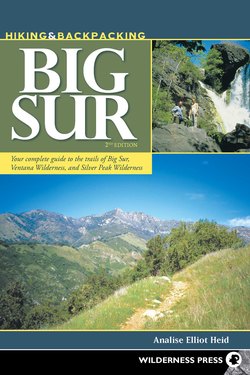Читать книгу Hiking and Backpacking Big Sur - Analise Elliot Heid - Страница 19
На сайте Литреса книга снята с продажи.
ОглавлениеTrip 3
CYPRESS GROVE TRAIL
LENGTH AND TYPE: 0.8-mile loop
RATING: Easy
TRAIL CONDITION: Well maintained, good for kids
HIGHLIGHTS: Stroll past gnarled Monterey cypress trees in one of only two remaining native groves of this species.
TO REACH THE TRAILHEAD: From the entrance station of the park, drive 0.8 mile to the Sea Lion Point parking area. The trailhead is on the north side of the lot, just past the restrooms and information kiosk. Water is available at the trailhead.
TREES THAT INSPIRED A RESERVE
Monterey cypress trees bear distinct twisted branches, shallow exposed roots, and dense flattened canopies. Their contorted appearance attests to the harsh environment of salt spray, rocky granite soil, and gale-force winds the trees must endure. Protection of the celebrated cypress prompted the acquisition of Point Lobos as a state reserve in 1933.
The Monterey cypress trees along North and South Point stand as a memorial to Mr. and Mrs. A.M. Allan, former owners of Point Lobos. In 1888 several land claimants banded together to develop a portion of the headland as residential lots. Fortunately, A.M. Allan, in conjunction with the Save-the-Redwoods League, had the foresight to buy back the residential lots, limit access, and seek public support to make Point Lobos part of the new state park system.
TRIP SUMMARY: This short, easy trail leads to overlooks of nearshore islands and rocky coves, where sea otters, harbor seals, and sea lions frolic amid multicolored kelp beds.
The Monterey cypress clings its bare roots to the sheer granite cliffs of Point Lobos.
Trip Description
From the information kiosk, the trail leads north and soon forks. The North Shore Trail heads off to the right, while the Cypress Grove Trail veers left 0.1 mile, then splits again into a loop trail through the Allan Memorial Grove. Taking the loop in either direction will lead you back to this junction.
Along the northwest fork, the trail offers views into Headland Cove, where with any luck you’ll see all three species of resident marine mammals: California sea lions, sea otters, and harbor seals. If thick summer fog obscures your view, listen for the boisterous barking of sea lions from nearshore rocks.
Strolling past Headland Cove, you soon enter the grove, one of only two naturally growing stands of Monterey cypress in the world (the other grove is at Cypress Point on the north end of Carmel Bay). In the colder, wetter climate of the Pleistocene epoch some 15,000 years ago, these wind-sculpted trees extended over a much wider range. As the climate slowly turned hotter and drier, the cypress trees withdrew to the cool, fog-shrouded coast. Closely inspect the branches and buttressed trunks to spot a deep orange velvety encrustation. This plush substance is lichen that coexists with the tree, using its branches merely as a roost rather than obtaining nourishment at the tree’s expense.
The trail soon veers right, offering dramatic views of secluded coves and granite pinnacles stretching north to Cypress Point. At North Point a spur climbs 50 feet to a rocky ledge. Clinging to crevices along the granite walls are such coastal plants as Dudleya, or bluff lettuce, featuring succulent silver leaves arranged in a spiral. In summer and fall especially, be sure to bring binoculars, as humpback and gray whales pass within sight of shore along their migratory route from Alaska to the Sea of Cortez, in Baja, Mexico.
Farther along the main trail, a long staircase leads down toward the blue-green waters of Cypress Cove, where you may distinguish the heads of several sea otters, resting on their backs atop an underwater forest of 70-foot giant bull kelp. Ascend the steps and continue along the main trail 0.1 mile to complete your loop around the peninsula. From here retrace your steps to the parking area.
